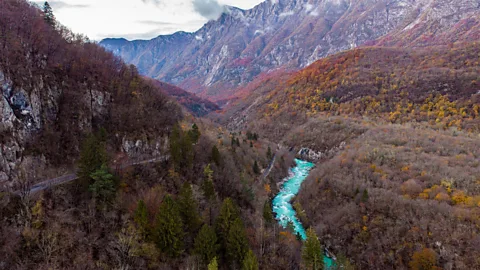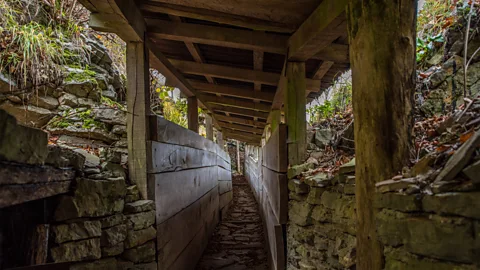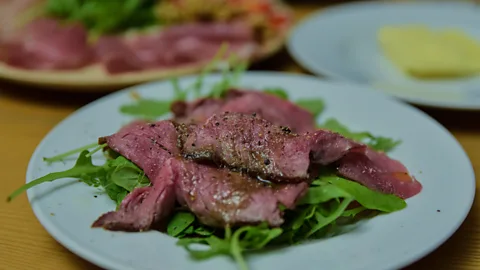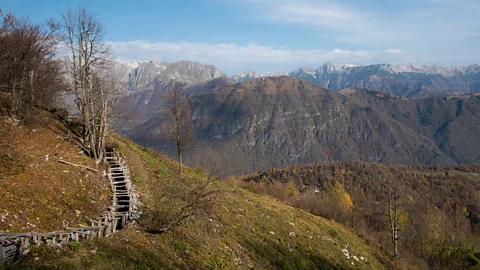The Walk of Peace: Europe's Alps-to-Adriatic hiking trail
 AlenaPaulus/Getty Images
AlenaPaulus/Getty ImagesSpanning two countries, this 270km-long path traces one of the bloodiest frontlines of World War One and now stands as a celebration of peace.
"When I was a kid, I hated walking; nevertheless, my father always took me with him to the mountains. On such hikes, my mother used to give me an invisible rope, which I tied around my waist so she could 'pull' me uphill," said our guide, Petra Rovšček, as she ed my partner and I the same invisible rope.
Unused to the slopes of north-western Slovenia, we were struggling to keep up with Rovšček's pace while marching to reach the Memorial Church of the Holy Spirit in Javorca. As Rovšček led us on a winding gravel road above a stream trickling with alpine water and under leaves blushing autumnal reds, she told us about her relationship with the unconventional shrine.
"For me it's more a person than a church. Whenever I visit it, I say hello to the [fallen soldier] boys. They're like brothers to me."
 Martina Žoldoš
Martina ŽoldošTucked in a valley high above the Tolminka River and surrounded by the steep peaks of the Rdeči rob and Tolmin mountain chains, the solitary wooden church honours the 2,564 Austro-Hungarian soldiers who lost their lives in 1916 on the nearby Tolmin battlefield as part of the Isonzo Front in World War One. The 90km-long front ran from the Alps to the Adriatic Sea along the Isonzo River near the historical border that once separated Italy and Austria. It had been formed a year earlier when Italy ed the Allies and declared war on Austria-Hungary. Two and a half years of positional warfare followed, and in all, the Isonzo represented one of the bloodiest frontlines in WWI, with more than 1.5 million soldiers killed, wounded or captured in the 12 battles that took place here between 1915 and 1917.
Today, most of the valley belongs to Slovenia, the Isonzo River is now known as the Soča, and the slopes around the church are overgrown with dense forest. But 100 years ago, the area was completely bare because locals used it as pasture for livestock.
"In winter, when the peaks were covered with up to 6m [of] thick snow, avalanches [killed] many soldiers on the Austro-Hungarian side. Desperate due to mass losses and an impossible situation they were in, the surviving soldiers decided to erect a monument to the fallen comrades-in-arms," explained Rovšček. The shrine was constructed by soldiers while resting after prolonged battles, and as Rovšček led us inside, we saw that the men had burnt the names of their 2,564 fallen brothers into oak s – a poignant reminder of the horrors that took place in this now picture-perfect setting.
Today, the lone church stands as a "memorial of reconciliation", and is one of 230 WWI monuments, trenches, caverns, cemeteries and forts in the Soča Valley that make up the Walk of Peace hiking trail: a living museum that reminds travellers of this valley's importance in the war, while also revealing how the unique rural culture of its residents has endured.
 Fernando E Hernandez Condado
Fernando E Hernandez CondadoStretching 270km and weaving between Slovenia and Italy, the main trail is divided into 15 one-day walking routes that run from Mt Rombon in the Julian Alps all the way to Trieste, Italy, on the Adriatic coast. In addition to the European Heritage-listed Javorca, the trail es through the Kluže Fortress high above the Koritnica gorge; the Sabotin Peace Park, a key defensive point of Austria-Hungary, and a protected habitat of rare bird species; and the 25m Monument of Peace and Observation Tower in Cerje, with panoramic views of the Adriatic Sea.
The Walk of Peace was inaugurated in March 2015 and has since expanded to include an additional 230km of new routes branching off from the trail's main spine – one leading to Kranjska Gora, a popular winter sports destination, and the other to the town Bohinjska Bistrica. Both the original trail and the two new routes venture into Triglav, Slovenia's only national park, whose high-altitude summits and crystal-clear lakes are home to brown bears, chamois and golden eagles.
You may also be interested in:
• The Minochoku Coastal Trail: Japan's new 1,000km path
I was born in Slovenia's northernmost region, Prekmurje, and this year, it celebrated the 100th anniversary of the arrival of first migrants from the Soča Valley region who had been displaced due to the war. Even now, many people I grew up with still feel a bond with the valley that was once their great-grandparents' home. So, after long wanting to explore the trail, I decided to lace up my shoes and learn more about the Great War – and my birth nation – by hiking a northern leg of the route.
 Martina Žoldoš
Martina ŽoldošWe started our exploration at the Italian army's open-air trenches at Kolovrat, a ridge with sweeping views into the Friuli lowlands in Italy, lined with a branched system of firing trenches and caverns where the last battle of the Isonzo Front took place. From there, the trail shot down into vast pastures filled with cows, whose milk is turned into traditional Tolminc cheese and spicy albumin curd.
In addition to teaching hikers about history, the Walk of Peace allows travellers to sample a highlight reel of Slovenian culinary specialties. After a long day of walking, I stayed overnight at the working farm Pri Kafolu near Tolmin and feasted on a pasture-to-plate selection of dried meat products, yoghurt, albumin curd and Tolminc cheese sourced from the cows just outside the window. The farm's owner, Tomaž Leban, explained that the cheese's consistent sweet, slightly spicy taste is the result of an 800-year-old local recipe.
Had I continued south to the town of Nova Gorica, I would have walked through the hilly vineyards of Goriška brda and the Karst region, where the fertile red soil produces blood-red Teran Slovenian wine, while the gusty cold wind dries fresh salted pig thighs and turns them into one of the most recognisable Slovenian delicacies: Kraški pršut, or Slovenian prosciutto.
 Martina Žoldoš
Martina ŽoldošThe region isn't only an important culinary hub; it's also a popular recreational spot for locals. "Everyone here practices some kind of sport: hiking, running, biking, skiing, climbing," confirmed Rovšček. Coming from the flat, endless wheat fields of Prekmurje in the opposite end of the country, I was struggling with the ascents. But gazing down at the rushing Soča and up at the snowcapped mountains, it was easy to understand why everyone I talked to seemed to love the great outdoors.
Although the trail was inspired by the memories of war, it also stands as a celebration of peace. When we were standing outside the church in Javorca, Rovšček called us to look up above the three Austrian-Hungarian coats of arms and a solar clock towards an inscription. "The word 'PAX' [peace] is written on the very top. It's the most important thing of all," she said.
Another goal of the trail is to promote harmony between the neighbouring nations that once fought against each other. "Since there are no living witnesses, ions and emotions have calmed down considerably. The legacy of WWI no longer separates people, but it really unites them," explained Maša Klavora, director of the Ustanova Fundacija Poti miru v Posočju, which helps manage the trail.
 Martina Žoldoš
Martina ŽoldošIn fact, after our initial ascent to ire the views from atop Kolovrat, we were standing right on the border between Slovenia and Italy. We could see the Soča Valley on the Slovenian side and the Friuli lowlands and the Gulf of Trieste on the Italian side. Breathless hikers from both nations greeted us as they savoured the victory of a successful climb. Until Slovenian independence in 1991, Yugoslav soldiers guarded this area of rocks and underground ditches trying to prevent people from ing from one country to another, said Leon Četrtič who leads groups of tourists to Kolovrat.
"Today, not only can we just walk over to Italy, but there we do our [errands], eat in restaurants or just go for a drink," he said. "The Italians do the same here in Slovenia. For us, the border doesn't exist anymore."
Slowcomotion is a BBC Travel series that celebrates slow, self-propelled travel and invites readers to get outside and reconnect with the world in a safe and sustainable way.
---
more than three million BBC Travel fans by liking us on Facebook, or follow us on Twitter and Instagram.
If you liked this story, sign up for the weekly bbc.com features newsletter called "The Essential List". A handpicked selection of stories from BBC Future, Culture, Worklife and Travel, delivered to your inbox every Friday.
